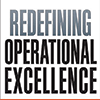 Author Andrew Miller warns that stale approaches and out-of-date operating methods diminish an organization’s potential for success. He offers a fresh approach in his book, “Redefining Operational Excellence.” Seasoned managers may point to old methods that brought success in the past and feel entitled to become complacent, but organizations that do “business as usual” by putting their operating procedures on “autopilot” are fading or failing, Miller shows.
Author Andrew Miller warns that stale approaches and out-of-date operating methods diminish an organization’s potential for success. He offers a fresh approach in his book, “Redefining Operational Excellence.” Seasoned managers may point to old methods that brought success in the past and feel entitled to become complacent, but organizations that do “business as usual” by putting their operating procedures on “autopilot” are fading or failing, Miller shows.
The author argues that old ways of thinking need to be challenged. He uses a systematic approach (chapter by chapter) to compare the thinking of the past and why adapting to different situations and circumstances and customizing to customer needs and expectations are necessary for sustainable growth and success.
This new way of thinking, Miller says, must be embedded in the organizational culture and must fit with new technologies, changes in industry structure and the educated workforce that expects to participate in decision making. Miller gives examples of old versus new thinking, which also changes the approach to problem solving, growth and operational excellence. A partial list is included below. A full explanation with rationale is given in the book. The concepts include:
- Top-down change (old) vs. engagement and empowerment to participative change (new)
- Productivity (old) vs. performance boost (new)
- Standardization (old) vs. customization (new)
- Eliminating waste (old) vs. driving innovation that also eliminates waste (new)
- Customer equality (old) vs. customer stratification (new)
- Customer satisfaction (old) vs. customer retention and referrals (new)
Innovative ways of thinking (mindsets) and new approaches to problem solving are the foundations of Miller’s book. He discusses four key components of operational excellence. They are:
- Attracting and retaining top talent: Rethink and go beyond simply “hiring.” Instead focus on recruiting talent and competencies needed to refresh the organization.
- Innovating and collaborating: Beware of becoming stale and seek out developing trends and methods by constantly seeking new information. Establish collaborating relationships with all stakeholders.
- Aligning strategy and tactics: Understand the difference between strategy (the “what”) and tactics (the “how”) and fine tune both by remaining open to new methods and change.
- Acquiring and keeping the customers you want: Establish a customer base that fits your competencies and mission. Keep this customer base and expand it. Do not try to please everyone. Focus on what your do best and serve those customers well.
The main drivers of change are the leaders within. Miller’s approach to leaderships is modern and relevant to the expectations and competencies of the modern workforce. We are reminded that leadership in our knowledge-worker organizations has changed. The centralized top-down decision making has segmented into decision units at the department and team level.
Miller’s approach is holistic rather than linear. It requires a peripheral vision of the talents, abilities and reliability of those who are given authority to make decision. This modern and more effective approach, he says, is to combine responsibility with authority.
This transfer of power to smaller units increases creative problem solving as individuals collaborate on finding new and better solutions to the challenges inherent in operating an organization. Leadership should emerge naturally according to competencies and situational challenges. These are basic empowerment methods that encourage loyalty and collaboration. The key to success is that the organizational culture instills a sense of integrative learning, reciprocity and respect.
“Redefining Operational Excellence” targets large or small business operations and gives useful examples for businesses on the operational excellence track. These examples are practical, relevant and make good sense. While Miller encourages new ways of thinking in solving problems, he gives respectful nods to old methods that can be adapted and incorporated to current challenges.
Although the book is written for businesses (the profit sectors) it should have larger audience. The value of the new way of thinking that Miller proposes will also benefit social entrepreneurs everywhere who strive for operational excellence in not-for-profit organizations.
Lucia Worthington is a successful entrepreneur and innovator and teaches business and management at Clark College in Vancouver. To recommend a book for review, email bookreviews@vbjusa.com.

